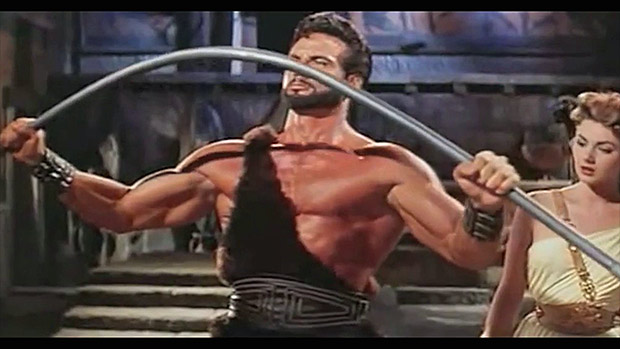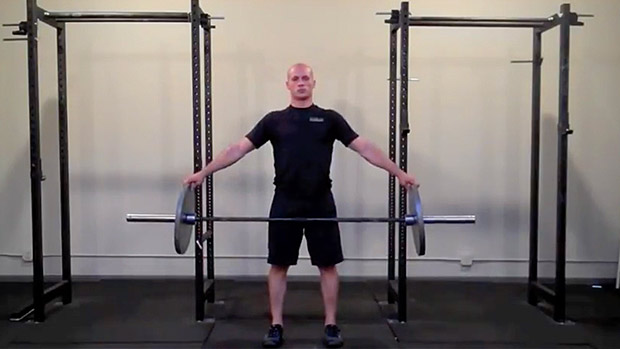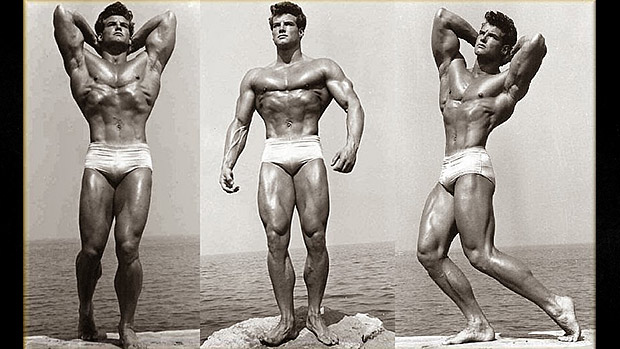Hercules Unchained
The Reeves deadlift is an old school exercise developed over six decades ago by one of the most famous bodybuilders of all time, Steve Reeves.

Reeves was known for having an incredible V-taper and massive upper back that was so visually stunning that he was cast as Hercules in several films. Although he used many upper back exercises in his workouts, a significant part of his Herculean physique can be attributed to the Reeves deadlift.

The Reeves deadlift involves an inordinately wide grip that's much wider than a snatch grip, so much so that you actually grip the edge or handles of the weight plates instead of the actual bar itself.
Although the wide grip crushes the upper back and lats, it's quite awkward and has multiple downfalls. Fortunately, these issues can be remedied by performing the Reeves deadlift with a trap bar. The video below shows a few variations:
Single-Leg Reeves Deadlift
Performing single-leg trap bar movements in the style of the Reeves deadlift provides the perfect stimulus for crushing every muscle in the body from head to toe while simultaneously working on balance, symmetry, and stability.
You can also expect some soreness and muscle growth in the glutes and hamstrings. As an added bonus, it's incredibly effective for improving foot and ankle strength, along with lower body mechanics.
- The traditional barbell version of the Reeves deadlift typically involves lighter weights as it's difficult to go big because of the extreme grip width. Although the wide grip really taxes the upper back and lats, the inability to overload it compromises its effectiveness as a great mass builder.
In fact, I'm fortunate if I can handle 222 pounds with traditional Reeves deadlifts. However, I can handle double that using the trap bar variation. In essence, the trap bar gives you the best of both worlds – a wide grip and significant overload. Just be prepared for some extreme upper back soreness followed by some serious functional hypertrophy and strength.
- The trap bar version of the Reeves deadlift involves a more natural starting position with solid 90-degree joint angles, as opposed to the barbell variation that requires you to stoop down much lower to reach the plates.
In fact, the standard Reeves deadlift, although it involves lighter loads, is also known for being hard on the low back. Most lifters will be unable to keep a neutral spine while over-reaching at the bottom position.
The trap bar version, on the other hand, allows you to set the spine in a tight, neutral position while still maintaining a mild natural arch that's imperative for safe deadlift mechanics. So, the starting position with the trap bar is much more low-back friendly and biomechanically sound.
- During the traditional Reeves deadlift, the combination of using a super-wide grip while holding a barbell that's loaded to the front of the body can expose the low back and spine to inordinate risk. Besides allowing a more natural wide grip, the trap bar variation of the Reeves deadlift is loaded directly in-line with the center of mass, rather than the front. In fact, that's the beauty of all trap bar deadlift variations.
- The traditional barbell Reeves deadlift is typically considered more of an upper-body movement rather than a leg builder because the limited loading capabilities make it difficult to fully tax the lower body. Fortunately, with the trap bar the legs get pummeled just as much as the upper body because you can really load it up. If you're looking for exercises that are full-body intensive, Reeves trap bar deadlifts are at the top of the list.
- Reeves trap bar deadlifts are highly versatile and can be modified in a multitude of ways to create some incredibly intense and effective exercises. Some of my favorites include eccentric/isometric deadlift squats, lunges, bent-over rows, farmer's walks, RDLs, Bulgarian squats, jump shrugs, split squats, single-leg squats, and more.
There are questions as to whether doing the traditional Reeves deadlift variation with an Olympic barbell is even worth it. The answer is yes and no. If you're going to perform a deadlift variation with a traditional Reeves-style grip and Olympic barbell, do them in a constant tension RDL fashion, rather than doing actual deadlifts from the floor.
There are several reasons why:
- Performing Reeves deadlifts from the floor with a traditional barbell doesn't provide enough constant tension to make up for the lack of overload. The RDL version, on the other hand, provides the constant tension that's necessary for building mass when the overload component is minimal.
- Remember, doing traditional Reeves deadlifts from the floor can be quite stressful on the spine and low back due to the exaggerated stooped-over position at the bottom that makes it difficult to keep a neutral spine.
But performing RDL versions where you terminate the end range of motion well before reaching the floor eliminates this issue altogether, making it both spine-friendly and hypertrophy inducing. To further reduce strain on the spine, walk the bar out from a squat rack rather than deadlifting it from the floor.
Although most of the Reeves exercises involve iron-grip style plates (with the built-in handles) because they allow the greatest overload effect, periodically doing the same movements with bumper plates or metal plates will annihilate your grip, hands, and forearms.
This same method can be used with deadlifts, farmer's walks, rows, Romanian deadlifts (RDL's), lunges, jump shrugs, and more.
Using the plate pinch method also helps dial in body mechanics and spinal rigidity. That's because the increased grip and hand activation creates a physiological phenomenon known as "concurrent activation potentiation" or irradiation. In other words, it helps improve full body tension, spinal rigidity, and elimination of energy leaks.
As a bonus, the inevitable use of relatively lighter loads allows the lifter to hone in on technique. Try using Reeves bumper plate variations (with a trap bar or Olympic bar) on days where you're looking to crush your grip, work on body mechanics, or deload the larger muscles of your body.
The traditional Reeves deadlift is only possible for lifters that are approximately 5'8" or above, or individuals with large wingspans in general. Those who are more vertically challenged or who aren't genetically blessed with a long reach will literally be unable to grip the plates on the barbell.
Fortunately, trap bars are roughly 25% shorter (from collar to collar), allowing lifters of all shapes, sizes, and heights to grip the plates.





